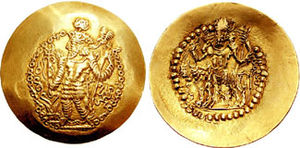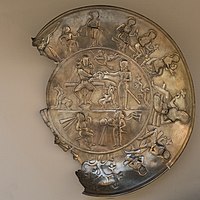| Kushano-Sasanian KingdomKushanshahr | |||||||||||
|---|---|---|---|---|---|---|---|---|---|---|---|
| c. 230 CE–c. 365 CE | |||||||||||
 Map of the domains governed by the Kushano-Sasanian Kingdom Map of the domains governed by the Kushano-Sasanian Kingdom | |||||||||||
| Capital | Balkh | ||||||||||
| Common languages | Middle Persian Bactrian | ||||||||||
| Religion | Buddhism Zoroastrianism Hinduism | ||||||||||
| Government | Feudal monarchy | ||||||||||
| Historical era | Late Antiquity | ||||||||||
| • Established | c. 230 CE | ||||||||||
| • Disestablished | c. 365 CE | ||||||||||
| |||||||||||
| Today part of | Pakistan Afghanistan Turkmenistan | ||||||||||
The Kushano-Sasanian Kingdom (or Indo-Sasanians) was a polity established by the Sasanian Empire in Bactria during the 3rd and 4th centuries. The Sasanian Empire captured the provinces of Sogdia, Bactria and Gandhara from the declining Kushan Empire following a series of wars in 225 CE. The local Sasanian governors then went on to take the title of Kushanshah (KΟÞANΟ ÞAΟ or Koshano Shao in the Bactrian language) or "King of the Kushans", and to mint coins. They are sometimes considered as forming a "sub-kingdom" inside the Sasanian Empire.
This administration continued until 360–370, when the Kushano-Sasanians lost much of their domains to the invading Kidarites; the remainder was incorporated into the Sasanian Empire proper. Later, the Kidarites were in turn displaced by the Hephthalites.
The Kushanshahs are mainly known through their coins. Their coins were minted at Kabul, Balkh, Herat, and Merv, attesting the extent of their realm.
A rebellion of Hormizd I Kushanshah (277–286 CE), who issued coins with the title Kushan-shahanshah ("King of kings of the Kushans"), seems to have occurred against contemporary emperor Bahram II (276–293 CE) of the Sasanian Empire, but failed.
History

The Sassanids, shortly after victory over the Parthians, extended their dominion into Bactria during the reign of Ardashir I around 230 CE, then further to the eastern parts of their empire in western Pakistan during the reign of his son Shapur I (240–270). Thus the Kushans lost their western territory (including Bactria and Gandhara) to the rule of Sassanid nobles named Kushanshahs or "Kings of the Kushans". The farthest extent of the Kushano-Sasanians to the east appears to have been Gandhara, and they apparently did not cross the Indus River, since almost none of their coinage has been found in the city of Taxila just beyond the Indus.
The Kushano-Sasanians under Hormizd I Kushanshah seem to have led a rebellion against contemporary emperor Bahram II (276-293 CE) of the Sasanian Empire, but failed. According to the Panegyrici Latini (3rd-4th century CE), there was a rebellion of a certain Ormis (Ormisdas) against his brother Bahram II, and Ormis was supported by the people of Saccis (Sakastan). Hormizd I Kushanshah issued coins with the title Kushanshahanshah ("King of kings of the Kushans"), probably in defiance of imperial Sasanian rule.
Around 325, Shapur II was directly in charge of the southern part of the territory, while in the north the Kushanshahs maintained their rule. Important finds of Sasanian coinage beyond the Indus in the city of Taxila only start with the reigns of Shapur II (r.309-379) and Shapur III (r.383-388), suggesting that the expansion of Sasanian control beyond the Indus was the result of the wars of Shapur II "with the Chionites and Kushans" in 350-358 as described by Ammianus Marcellinus. They probably maintained control until the rise of the Kidarites under their ruler Kidara.
The decline of the Kushans and their defeat by the Kushano-Sasanians and the Sasanians, was followed by the rise of the Kidarites and then the Hephthalites (Alchon Huns) who in turn conquered Bactria and Gandhara and went as far as central India. They were later followed by Turk Shahi and then the Hindu Shahi, until the arrival of Muslims to north-western parts of India.
Religious influences

Obv: Bahram with characteristic headdress.
Rev: Shiva with Nandi in Kushan style.
Coins depicting Shiva and Nandi have been discovered, indicating a strong influence of Shaivism.
The prophet Mani (210–276), founder of Manichaeism, followed the Sasanian expansion to the east, which exposed him to the thriving Buddhist culture of Gandhara. He is said to have visited Bamiyan, where several religious paintings are attributed to him, and is believed to have lived and taught for some time. He is also related to have sailed to the Indus Valley area (now in Pakistan) in 240 or 241 and converted a Buddhist king, the Turan Shah of India.
On that occasion, various Buddhist influences seem to have permeated Manichaeism: "Buddhist influences were significant in the formation of Mani's religious thought. The transmigration of souls became a Manichaean belief, and the quadripartite structure of the Manichaean community, divided between male and female monks (the 'elect') and lay follower (the 'hearers') who supported them, appears to be based on that of the Buddhist sangha".
Coinage
The Kushano-Sassanids created an extensive coinage with legend in Brahmi, Pahlavi or Bactrian, sometimes inspired from Kushan coinage, and sometimes more clearly Sassanid.
The obverse of the coin usually depicts the ruler with elaborate headdress and on the reverse either a fire temple or Shiva with Nandi.
-
 Kushano-Sasanian ruler Ardashir I Kushanshah, circa 230-250 CE. Merv mint.
Kushano-Sasanian ruler Ardashir I Kushanshah, circa 230-250 CE. Merv mint.
-
 Ardashir I Kushanshah in the name of Kushan ruler Vasudeva I, circa 230-245 CE.
Ardashir I Kushanshah in the name of Kushan ruler Vasudeva I, circa 230-245 CE.
-
 Hormizd I Kushanshah with mention of Mazda and Anahita. Merv mint.
Hormizd I Kushanshah with mention of Mazda and Anahita. Merv mint.
-
 Indo-Sassanid coin.
Indo-Sassanid coin.
-
 A gold Indo-Sassanid coin.
A gold Indo-Sassanid coin.
Kushano-Sasanian art
The Indo-Sassanids traded goods such as silverware and textiles depicting the Sassanid emperors engaged in hunting or administering justice.
-
 Kushano-Sasanian footed cup with medallion, 3rd-4th century CE, Bactria, Metropolitan Museum of Art.
Kushano-Sasanian footed cup with medallion, 3rd-4th century CE, Bactria, Metropolitan Museum of Art.
-
 Possible Kushano-Sasanian plate, excavated in Rawalpindi, Pakistan, 350-400 CE. British Museum 124093.
Possible Kushano-Sasanian plate, excavated in Rawalpindi, Pakistan, 350-400 CE. British Museum 124093.
-
 Terracotta head of a male figure, Kushano-Sasanian period, Gandhara region, 4th-5th century CE
Terracotta head of a male figure, Kushano-Sasanian period, Gandhara region, 4th-5th century CE
-
 A probable Kushano-Sasanian plate with hunting scene, found in the 504 CE tomb of Feng Hetu in China. Shanxi Museum. It is dated the 3rd-4th century CE, and was probably manufactured in northern Afghanistan.
A probable Kushano-Sasanian plate with hunting scene, found in the 504 CE tomb of Feng Hetu in China. Shanxi Museum. It is dated the 3rd-4th century CE, and was probably manufactured in northern Afghanistan.
Artistic influences

The example of Sassanid art was influential on Kushan art, and this influence remained active for several centuries in the northwest South Asia. Plates seemingly belonging to the art of the Kushano-Sasanians have also been found in Northern Wei tombs in China, such as a plate depicting a boar hunt found in the 504 CE tomb of Feng Hetu.
Main Kushano-Sassanid rulers
The following Kushanshahs were:
- Ardashir I Kushanshah (230–245)
- Peroz I Kushanshah (245–275)
- Hormizd I Kushanshah (275–300)
- Hormizd II Kushanshah (300–303)
- Peroz II Kushanshah (303–330)
- Varahran Kushanshah (330–365)
See also
| History of South Asia | |||||||||||||||||||||||||||||||||||||||||||||||||||||||||||||||||||||||||||||||||||||||||||||||||||||||||||||||||||||||||||||||||||||||||||||||||||||||||||||||||||||||||||||||||||||||||||||||||||||||||||||||||||||||||||||||||||||||||||||||||||||||||||||||||||||||||||||||||||||||||
|---|---|---|---|---|---|---|---|---|---|---|---|---|---|---|---|---|---|---|---|---|---|---|---|---|---|---|---|---|---|---|---|---|---|---|---|---|---|---|---|---|---|---|---|---|---|---|---|---|---|---|---|---|---|---|---|---|---|---|---|---|---|---|---|---|---|---|---|---|---|---|---|---|---|---|---|---|---|---|---|---|---|---|---|---|---|---|---|---|---|---|---|---|---|---|---|---|---|---|---|---|---|---|---|---|---|---|---|---|---|---|---|---|---|---|---|---|---|---|---|---|---|---|---|---|---|---|---|---|---|---|---|---|---|---|---|---|---|---|---|---|---|---|---|---|---|---|---|---|---|---|---|---|---|---|---|---|---|---|---|---|---|---|---|---|---|---|---|---|---|---|---|---|---|---|---|---|---|---|---|---|---|---|---|---|---|---|---|---|---|---|---|---|---|---|---|---|---|---|---|---|---|---|---|---|---|---|---|---|---|---|---|---|---|---|---|---|---|---|---|---|---|---|---|---|---|---|---|---|---|---|---|---|---|---|---|---|---|---|---|---|---|---|---|---|---|---|---|---|---|---|---|---|---|---|---|---|---|---|---|---|---|---|---|---|---|---|---|---|---|---|---|---|---|---|---|---|---|---|---|---|---|
 | |||||||||||||||||||||||||||||||||||||||||||||||||||||||||||||||||||||||||||||||||||||||||||||||||||||||||||||||||||||||||||||||||||||||||||||||||||||||||||||||||||||||||||||||||||||||||||||||||||||||||||||||||||||||||||||||||||||||||||||||||||||||||||||||||||||||||||||||||||||||||
Outline
|
|||||||||||||||||||||||||||||||||||||||||||||||||||||||||||||||||||||||||||||||||||||||||||||||||||||||||||||||||||||||||||||||||||||||||||||||||||||||||||||||||||||||||||||||||||||||||||||||||||||||||||||||||||||||||||||||||||||||||||||||||||||||||||||||||||||||||||||||||||||||||
| National histories | |||||||||||||||||||||||||||||||||||||||||||||||||||||||||||||||||||||||||||||||||||||||||||||||||||||||||||||||||||||||||||||||||||||||||||||||||||||||||||||||||||||||||||||||||||||||||||||||||||||||||||||||||||||||||||||||||||||||||||||||||||||||||||||||||||||||||||||||||||||||||
| Regional histories | |||||||||||||||||||||||||||||||||||||||||||||||||||||||||||||||||||||||||||||||||||||||||||||||||||||||||||||||||||||||||||||||||||||||||||||||||||||||||||||||||||||||||||||||||||||||||||||||||||||||||||||||||||||||||||||||||||||||||||||||||||||||||||||||||||||||||||||||||||||||||
| Specialised histories | |||||||||||||||||||||||||||||||||||||||||||||||||||||||||||||||||||||||||||||||||||||||||||||||||||||||||||||||||||||||||||||||||||||||||||||||||||||||||||||||||||||||||||||||||||||||||||||||||||||||||||||||||||||||||||||||||||||||||||||||||||||||||||||||||||||||||||||||||||||||||
References
- ^ The Cambridge History of Iran, Volume 3, E. Yarshater p.209 ff
- Rezakhani, Khodadad (2021). "From the Kushans to the Western Turks". King of the Seven Climes: 204.
- The Cambridge Companion to the Age of Attila, Michael Maas, Cambridge University Press, 2014 p.284 ff
- Rezakhani 2017b, p. 83.
- Sasanian Seals and Sealings, Rika Gyselen, Peeters Publishers, 2007, p.1
- ^ Encyclopedia Iranica
- ^ Ghosh, Amalananda (1965). Taxila. CUP Archive. pp. 790–791.
- ^ CNG Coins
- ^ Richard Foltz, Religions of the Silk Road, New York: Palgrave Macmillan, 2010
- CNG Coins
- "Metropolitan Museum of Art". www.metmuseum.org.
- For the precise date: Sundermann, Werner; Hintze, Almut; Blois, François de (2009). Exegisti Monumenta: Festschrift in Honour of Nicholas Sims-Williams. Otto Harrassowitz Verlag. p. 284, note 14. ISBN 978-3-447-05937-4.
- "Plate British Museum". The British Museum.
- Sims, Vice-President Eleanor G.; Sims, Eleanor; Marshak, Boris Ilʹich; Grube, Ernst J.; I, Boris Marshak (January 2002). Peerless Images: Persian Painting and Its Sources. Yale University Press. p. 13. ISBN 978-0-300-09038-3.
- ^ Carter, M.L. "Encyclopaedia Iranica". iranicaonline.org.
A gilt silver plate depicting a princely boar hunt, excavated from a tomb near Datong dated to 504 CE, is close to early Sasanian royal hunting plates in style and technical aspects, but diverges enough to suggest a Bactrian origin dating from the era of the Kushano-Sasanian rule (ca. 275-350 CE)
- HARPER, PRUDENCE O. (1990). "An Iranian Silver Vessel from the Tomb of Feng Hetu". Bulletin of the Asia Institute. 4: 51–59. ISSN 0890-4464. JSTOR 24048350.
- Watt, James C. Y. (2004). China: Dawn of a Golden Age, 200-750 AD. Metropolitan Museum of Art. pp. 152–153. ISBN 978-1-58839-126-1.
- "Seal British Museum". The British Museum.
- "a Sasanian prince is represented adoring before the Indian god Vishnu" in Herzfeld, Ernst (1930). Kushano-Sasanian Coins. Government of India central publication branch. p. 16.
- "South Asia Bulletin: Volume 27, Issue 2". South Asia Bulletin. University of California, Los Angeles. 2007. p. 478:
A seal inscribed in Bactrian , fourth to fifth century AD , shows a Kushano - Sasanian or Kidarite official worshipping Vishnu : Pierfrancesco Callieri , Seals and Sealings from the North - West of the Indian Subcontinent and Afghanistan.
- Rezakhani 2017b, p. 78.
Sources
- Cribb, Joe (2018). Rienjang, Wannaporn; Stewart, Peter (eds.). Problems of Chronology in Gandhāran Art: Proceedings of the First International Workshop of the Gandhāra Connections Project, University of Oxford, 23rd-24th March, 2017. University of Oxford The Classical Art Research Centre Archaeopress. ISBN 978-1-78491-855-2.

- Cribb, Joe (2010). Alram, M. (ed.). "The Kidarites, the numismatic evidence.pdf". Coins, Art and Chronology Ii, Edited by M. Alram et al. Coins, Art and Chronology II: 91–146.

- Daryaee, Touraj; Rezakhani, Khodadad (2017a). "The Sasanian Empire". In Daryaee, Touraj (ed.). King of the Seven Climes: A History of the Ancient Iranian World (3000 BCE - 651 CE). UCI Jordan Center for Persian Studies. pp. 1–236. ISBN 978-0-692-86440-1.
- Payne, Richard (2016). "The Making of Turan: The Fall and Transformation of the Iranian East in Late Antiquity". Journal of Late Antiquity. 9. Baltimore: Johns Hopkins University Press: 4–41. doi:10.1353/jla.2016.0011. S2CID 156673274.

- Rapp, Stephen H. (2014). The Sasanian World through Georgian Eyes: Caucasia and the Iranian Commonwealth in Late Antique Georgian Literature. London: Ashgate Publishing, Ltd. ISBN 978-1-4724-2552-2.
- Rezakhani, Khodadad (2017b). "East Iran in Late Antiquity". ReOrienting the Sasanians: East Iran in Late Antiquity. Edinburgh University Press. pp. 1–256. ISBN 978-1-4744-0030-5. JSTOR 10.3366/j.ctt1g04zr8. (registration required)
- Rypka, Jan; Jahn, Karl (1968). History of Iranian literature. D. Reidel. ISBN 9789401034791.
- Sastri, Nilakanta (1957). A Comprehensive History of India: The Mauryas & Satavahanas. Orient Longmans. p. 246. ISBN 9788170070030.
- Vaissière, Étienne de La (2016). "Kushanshahs i. History". Encyclopaedia Iranica.
- Wiesehöfer, Joseph (1986). "Ardašīr I i. History". Encyclopaedia Iranica, Vol. II, Fasc. 4. pp. 371–376.
External links
| History of Central Asia | |||||||||||||||||||||
|---|---|---|---|---|---|---|---|---|---|---|---|---|---|---|---|---|---|---|---|---|---|
| Polities |
| ||||||||||||||||||||
| Culture | |||||||||||||||||||||
| Archaeology |
| ||||||||||||||||||||
| Artifacts |
| ||||||||||||||||||||
| Rulers of ancient Central Asia | |||||||||||||||||||||||||||||||||||||||||||||||||||||||||||||||||||||||||||||||||||||||||||||||||||||||||||||||||||||||||||||||||||||||||||||||||||||||||||||||||||||||||||||||||||||||||||||||||||||||||||||||||||||||||||||||||||||||||||
|---|---|---|---|---|---|---|---|---|---|---|---|---|---|---|---|---|---|---|---|---|---|---|---|---|---|---|---|---|---|---|---|---|---|---|---|---|---|---|---|---|---|---|---|---|---|---|---|---|---|---|---|---|---|---|---|---|---|---|---|---|---|---|---|---|---|---|---|---|---|---|---|---|---|---|---|---|---|---|---|---|---|---|---|---|---|---|---|---|---|---|---|---|---|---|---|---|---|---|---|---|---|---|---|---|---|---|---|---|---|---|---|---|---|---|---|---|---|---|---|---|---|---|---|---|---|---|---|---|---|---|---|---|---|---|---|---|---|---|---|---|---|---|---|---|---|---|---|---|---|---|---|---|---|---|---|---|---|---|---|---|---|---|---|---|---|---|---|---|---|---|---|---|---|---|---|---|---|---|---|---|---|---|---|---|---|---|---|---|---|---|---|---|---|---|---|---|---|---|---|---|---|---|---|---|---|---|---|---|---|---|---|---|---|---|---|---|---|---|---|---|---|---|---|---|---|---|---|---|---|---|---|---|---|---|---|
| |||||||||||||||||||||||||||||||||||||||||||||||||||||||||||||||||||||||||||||||||||||||||||||||||||||||||||||||||||||||||||||||||||||||||||||||||||||||||||||||||||||||||||||||||||||||||||||||||||||||||||||||||||||||||||||||||||||||||||
| Middle kingdoms of India | |||||||||||||||||||||||||||||||||||||||||||||||||||||||||||||||||||||||||||||||||||||||||||||||||||||||||||||||||||||||||||||||||||||||||||||||||||||||||||||||||||||||||||||
|---|---|---|---|---|---|---|---|---|---|---|---|---|---|---|---|---|---|---|---|---|---|---|---|---|---|---|---|---|---|---|---|---|---|---|---|---|---|---|---|---|---|---|---|---|---|---|---|---|---|---|---|---|---|---|---|---|---|---|---|---|---|---|---|---|---|---|---|---|---|---|---|---|---|---|---|---|---|---|---|---|---|---|---|---|---|---|---|---|---|---|---|---|---|---|---|---|---|---|---|---|---|---|---|---|---|---|---|---|---|---|---|---|---|---|---|---|---|---|---|---|---|---|---|---|---|---|---|---|---|---|---|---|---|---|---|---|---|---|---|---|---|---|---|---|---|---|---|---|---|---|---|---|---|---|---|---|---|---|---|---|---|---|---|---|---|---|---|---|---|---|---|---|---|
| |||||||||||||||||||||||||||||||||||||||||||||||||||||||||||||||||||||||||||||||||||||||||||||||||||||||||||||||||||||||||||||||||||||||||||||||||||||||||||||||||||||||||||||
| Provinces of the Sasanian Empire | ||
|---|---|---|
| ||
| * indicates short living provinces | ||
| Dynasty |  | |
|---|---|---|
| Culture | ||
| Military and wars | ||
| Descendants | ||
| Related | ||
Categories:



